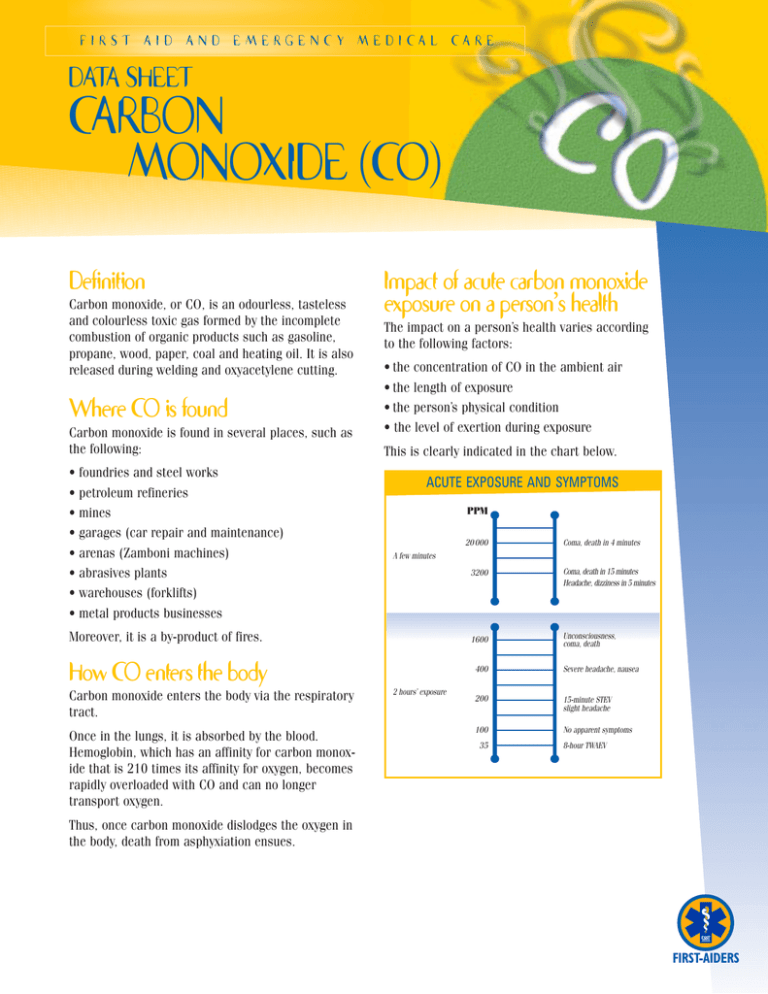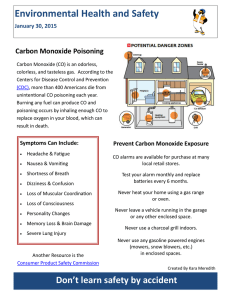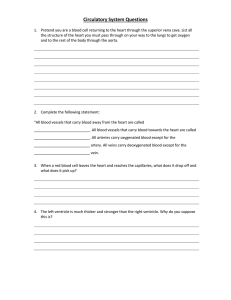carbon monoxide (co)
advertisement

F I R S T A I D A N D E M E RG E N C Y M E D I CA L CA R E DATA SHEET CARBON MONOXIDE (CO) Definition Carbon monoxide, or CO, is an odourless, tasteless and colourless toxic gas formed by the incomplete combustion of organic products such as gasoline, propane, wood, paper, coal and heating oil. It is also released during welding and oxyacetylene cutting. Where CO is found Carbon monoxide is found in several places, such as the following: • foundries and steel works • petroleum refineries • mines • garages (car repair and maintenance) • arenas (Zamboni machines) • abrasives plants • warehouses (forklifts) • metal products businesses Impact of acute carbon monoxide exposure on a person’s health The impact on a person’s health varies according to the following factors: • the concentration of CO in the ambient air • the length of exposure • the person’s physical condition • the level of exertion during exposure This is clearly indicated in the chart below. ACUTE EXPOSURE AND SYMPTOMS PPM 20 000 Moreover, it is a by-product of fires. How CO enters the body Carbon monoxide enters the body via the respiratory tract. Once in the lungs, it is absorbed by the blood. Hemoglobin, which has an affinity for carbon monoxide that is 210 times its affinity for oxygen, becomes rapidly overloaded with CO and can no longer transport oxygen. Coma, death in 4 minutes A few minutes 2 hours’ exposure 3200 Coma, death in 15 minutes Headache, dizziness in 5 minutes 1600 Unconsciousness, coma, death 400 Severe headache, nausea 200 15-minute STEV slight headache 100 No apparent symptoms 35 8-hour TWAEV Thus, once carbon monoxide dislodges the oxygen in the body, death from asphyxiation ensues. FIRST-AIDERS The following chart shows the impact of carboxyhemoglobin levels on health. CARBOXYHEMOGLOBIN/HEALTH Blood CO Cumulative symptoms 80 % 70 % Coma, convulsions, death 60 % 50 % 40 % 30 % Confusion, agitation, nausea, vomiting, unconsciousness Drowsiness, irritability, visual disturbances, trouble thinking 20 % Headache, diminished reflexes 10 % 0% Loss of mental acuity, shortness of breath Smokers Non-smokers Smoking is a major aggravating factor, as it increases the carboxyhemoglobin level by as much as 5 to 10 times the level in non-smokers, thereby increasing the risk of carbon monoxide poisoning. First aid and emergency medical care ■ Inhalation • Transport the victim immediately to a place with uncontaminated fresh air. If the victim is conscious and breathing, • settle him or her in a comfortable, semi-seated position, and • administer oxygen (if it is available and you have the necessary training). When the victim breathes carbon monoxide-free ambient air, the concentration of carboxyhemoglobin is reduced by half approximately every four hours. If oxygen is administered, the reduction can take as little as 40 minutes. If the victim is unconscious or not breathing, • begin cardiopulmonary resuscitation (CPR). IN ALL CASES The first-aider must • ensure the victim is comfortable (warm, resting); • have the victim transported to the hospital emergency ward, indicating possible CO poisoning; • report the accident to the immediate supervisor and to health services or personnel services. Emergency intervention What to do in the event of a carbon monoxide leak 1. Take rapid action. 2. Follow the establishment’s emergency measures plan and the procedure for evacuating injured persons. 3. Call 911. 4. Stop the source of the poisoning, if possible. 5. Air the room. 6. Use adequate personal protection so as not to become a victim yourself. Reference Robert Lauwerys, Toxicologie industrielle et intoxication professionnelle, 3rd edition, Paris-Milan-Barcelona-Bonn, Masson, 1992, pp. 404, 411. RRSSS Mauricie–Bois-Francs and CLSC Drummond, CLSC Centre-de-la-Mauricie and CLSC Du Rivage, Le monoxyde de carbone en milieu de travail, winter 1996. Prepared by: Comité régional des soins infirmiers en santé au travail au regard des premiers secours et des premiers soins. RÉGION DE LA MAURICIE ET DU CENTRE-DU-QUÉBEC CLSC SANTÉ AU TRAVAIL





